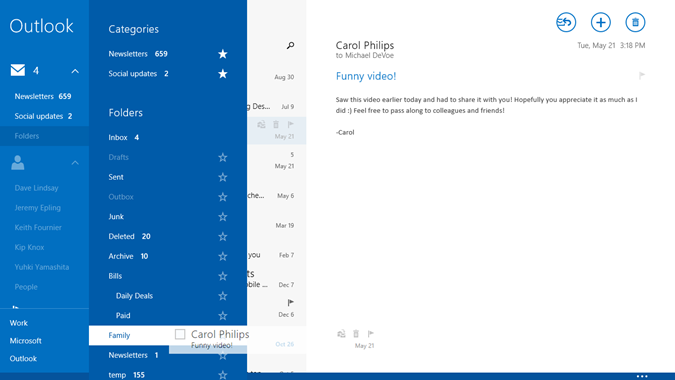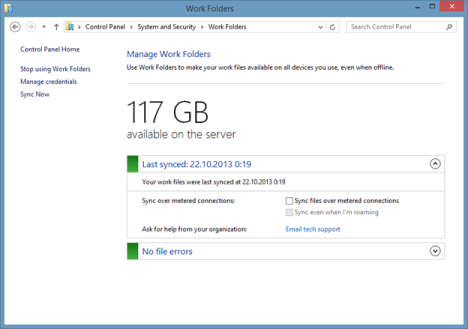

- #Windows 8.1 sync folders how to
- #Windows 8.1 sync folders mac os x
- #Windows 8.1 sync folders code
- #Windows 8.1 sync folders windows 8
You can use this trick to synchronize folders outside your cloud storage folder, too. Ln -s “/Users/name/Google Drive/ExternalFolder” “/path/to/ExternalFolder” Mv “/path/to/ExternalFolder” “/Users/name/Google Drive/” This command will move the entire folder to your cloud storage folder. In the first command, replace “C:\Path\To\ExternalFolder” with the path to the folder you want to sync and “C:\Users\NAME\Dropbox” with the path to your cloud storage folder. Type the following commands into the Command Prompt window. On Windows 7, open the Start menu, perform a search for Command Prompt, right-click the Command Prompt shortcut, and select Run as Administrator.
#Windows 8.1 sync folders windows 8
On Windows 8 or 10, press Windows Key + X and click Command Prompt (Admin). RELATED: The Complete Guide to Creating Symbolic Links (aka Symlinks) on Windows Windowsįirst, open a Command Prompt window as Administrator.
#Windows 8.1 sync folders how to
We first covered this solution when we looked at how to synchronize any folder with OneDrive on Windows 8.1. Dropbox would synchronize the files in the folder and the programs that need the folder at C:\Stuff would function normally. We’d then create a symbolic link at C:\Stuff pointing to the Dropbox\Stuff folder. In our example, we’d move the entire C:\Stuff folder to Dropbox’s folder. We can still use symbolic links in reverse, though. In practice, many cloud storage services no longer work properly with symbolic links. You could create a symbolic link in the Dropbox folder that points to C:\Stuff and Dropbox would synchronize everything inside the C:\Stuff folder. Programs on the computer see the link as if if it were the same as the real folder or files.įor example, let’s say you wanted to synchronize all the files in C:\Stuff with Dropbox, but you still want them in C:\Stuff. A symbolic link is just a “pointer” that points at a folder elsewhere.
#Windows 8.1 sync folders mac os x
There are many other suggestions in this thread, so if this doesn't work for you, hopefully one of the others will be of use.Windows, Linux, and Mac OS X all have integrated tools for creating symbolic links.
#Windows 8.1 sync folders code
Hopefully this fixed your issue and no more Error Code 5 errors will happen again. You have to run it inside a DOS window, just like the ' attrib' command in step 1 above, something like this:Īgain, just replace the example path ( c:\temp\*) with the path to your own files.ģ) Now, try running FreeFileSync to copy your files. It will turn off *ALL* Block flags for the files you give it (again, several hundred files in my case). The reason for turning off the read-only flag of the Blocked files is because the next step won't work for any file with a read-only flag set.Ģ) Download a program from SysInternals called ' Streams.exe' here:

Just replace the example path ( c:\temp\*) with the path to your own files. Easiest way to do this is just use the DOS ' attrib' command from inside a DOS window - something like this: After many hours of frustration and digging online, the solution (for my situation) turned out to be this:ġ) Turn off all read-only flags on the files that are also Blocked. If it shows an 'Unblock' button near the bottom of the window, and maybe this message: 'Security: This file came from another computer and might be blocked to help protect this computer.', then you've got a Blocked file.) For me, this was under Win7 圆4 SP1. (To verify this for yourself, right-click any file that causes the Error Code 5 in FreeFileSync and select Properties, then click the General tab.

In a quick nutshell, mine occurred when using FreeFileSync to copy several hundred files between 2 local hard-drives on my desktop computer - these files happened to *all* have a Block flag set. My Error Code 5 issues (when using FreeFileSync) were from something completely different from other suggestions in this thread. I realize I'm 3-4 years late to this thread, but I wanted to share this for anybody who might need the help.


 0 kommentar(er)
0 kommentar(er)
